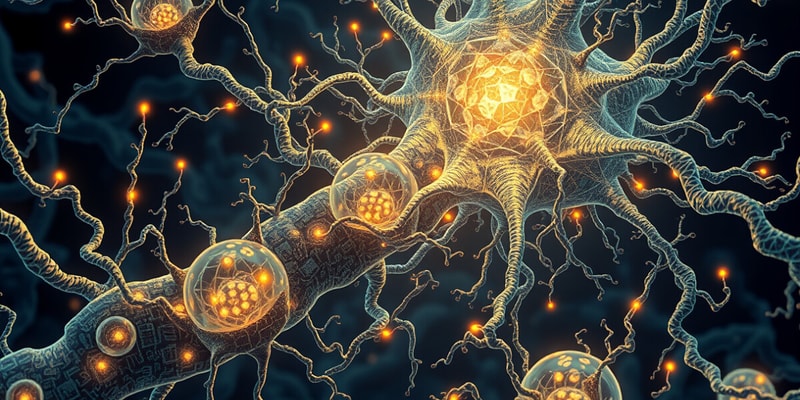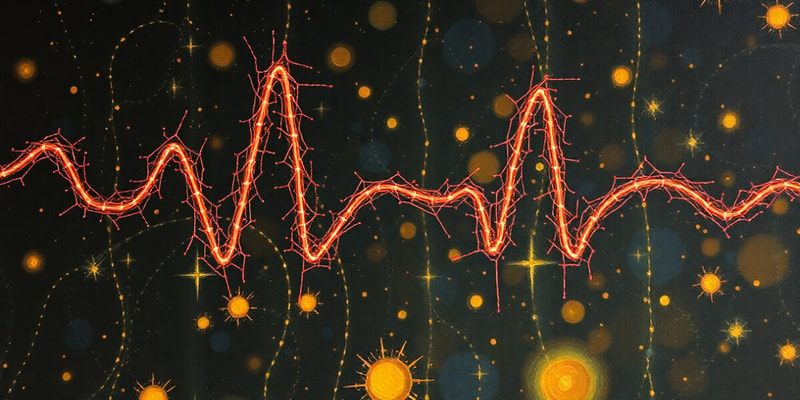Podcast Beta
Questions and Answers
What defines an action potential in neurons?
How does the electrical signal in neurons differ from that in wires?
What term is used to describe the nature of action potentials?
What role do dendrites play in neuronal communication?
Signup and view all the answers
What is the primary mode of signal transmission in neurons during an action potential?
Signup and view all the answers
What is the primary reason for the negative resting potential in a neuron?
Signup and view all the answers
How does sodium (Na+) move across the neuronal membrane?
Signup and view all the answers
What happens during the action potential in neurons?
Signup and view all the answers
What is the result of the sodium-potassium pump's activity?
Signup and view all the answers
Which ions are involved in establishing the resting membrane potential?
Signup and view all the answers
What is the role of dendrites in neuronal communication?
Signup and view all the answers
What ion concentration is higher outside the neuron compared to inside?
Signup and view all the answers
What initiates the propagation of an action potential down the axon?
Signup and view all the answers
Which amino acid is a precursor for the synthesis of dopamine?
Signup and view all the answers
Which of the following dopamine receptors is considered excitatory?
Signup and view all the answers
How is serotonin deactivated in the nervous system?
Signup and view all the answers
What is a common characteristic of noradrenaline receptors?
Signup and view all the answers
Which neurotransmitter is synthesized from dopamine?
Signup and view all the answers
Which enzyme is involved in the breakdown of dopamine?
Signup and view all the answers
What type of receptors do serotonin molecules primarily interact with?
Signup and view all the answers
Which of the following is NOT a function of dopamine receptor subtypes?
Signup and view all the answers
What behavioral disorder can be treated with L-Dopa?
Signup and view all the answers
How does the body primarily excrete excess dopamine?
Signup and view all the answers
What is the primary function of the axon terminals in a neuron?
Signup and view all the answers
Which of the following correctly defines a graded potential?
Signup and view all the answers
What is the significance of the resting potential in neurons?
Signup and view all the answers
Which neurotransmitter is primarily involved in the modulation of mood and emotion?
Signup and view all the answers
What does saltatory conduction refer to in neuronal communication?
Signup and view all the answers
What distinguishes the two classes of receptors associated with neurotransmitters?
Signup and view all the answers
Which mechanism is NOT commonly involved in the deactivation of neurotransmitters?
Signup and view all the answers
Where are most neurotransmitters synthesized within a neuron?
Signup and view all the answers
What role do calcium ions play in neurotransmitter release?
Signup and view all the answers
What is the primary mechanism by which neurotransmitters are released into the synaptic cleft?
Signup and view all the answers
Which type of receptors open or close ion channels directly upon neurotransmitter binding?
Signup and view all the answers
What happens when a neurotransmitter binds to a metabotropic receptor?
Signup and view all the answers
What is one of the mechanisms by which neurotransmitters are deactivated?
Signup and view all the answers
Which option describes how reuptake works in the context of neurotransmission?
Signup and view all the answers
What happens when neurotransmitters diffuse across the synaptic cleft?
Signup and view all the answers
What is the function of calmodulin in neurotransmitter release?
Signup and view all the answers
What is a key characteristic of ionotropic receptors compared to metabotropic receptors?
Signup and view all the answers
Which neurotransmitter example is synthesized in the axon terminal from components typically found in food?
Signup and view all the answers
Study Notes
Neuronal Membrane
- Negatively charged anions (A-) are produced inside the neuron and cannot leave
- Sodium ions (Na+) are positively charged and do not move freely across the membrane
- Sodium-potassium pump actively pumps 3 Na+ out for every 2 K+ brought inside the neuronal membrane
- This exchange of ions ensures a negative resting potential
Resting Membrane Potential
- Higher concentration of positively charged ions outside the membrane
- Higher concentration of negatively charged ions inside the membrane
Neuronal Communication
- Neurons communicate through electrochemical signals
- Chemical messengers (neurotransmitters) are received by the dendrites
- An electrical event, known as an action potential, propagates down the axon
- This triggers the release of neurotransmitters from the presynaptic terminal
Action Potentials
- Occur due to a rapid exchange of ions across the neuronal membrane
- Characterized by a series of voltage reversals along the axon
- "All or nothing" response, meaning they either occur or do not occur
Action Potential vs. Electrical Signal in Wires
- Electrical wires conduct a flow of electrons
- Neurons conduct impulses that are electrical in nature
- Neuron signals, known as action potentials, involve ion movement, not electron movement
Action Potential Stages
-
Stage 1: Dendrites receive neurotransmitters
- Receptors in dendrites bind to neurotransmitters
-
Stage 2: Neurotransmitter Release
- Action potential reaches the axon terminal, opening calcium channels
- Calcium ions bind to calmodulin, forming a calcium-calmodulin complex
- Calcium-calmodulin complex binds to synaptic vesicles, facilitating release of neurotransmitters through exocytosis
-
Stage 3: Receptor Activation
- Neurotransmitters diffuse across the synaptic cleft and bind to receptors on the postsynaptic membrane
- Receptor activation can be excitatory or inhibitory, causing changes in the postsynaptic membrane potential
- Two types of receptors:
- Ionotropic receptors: Ligand-gated ion channels that directly open or close ion channels upon neurotransmitter binding
- Metabotropic receptors: G-coupled receptors that activate G-proteins, which can interact with ion channels or create intracellular messengers
-
Stage 4: Deactivation of Neurotransmitters
- Neurotransmitters are deactivated through several mechanisms:
- Diffusion: Moving away from the synaptic cleft
- Degradation: Enzymes break down the neurotransmitter
- Reuptake: Neurotransmitter is taken back into the presynaptic neuron
- Removal: Glial cells bind and remove the neurotransmitter
- Neurotransmitters are deactivated through several mechanisms:
Neurotransmitter Synthesis and Deactivation
Acetylcholine
- Synthesized in the axon terminal from acetyl coenzyme A and choline
- Deactivated by the enzyme acetylcholinesterase
Dopamine
- Synthesized from L-Dopa, which comes from tyrosine
- Deactivated by enzymes, with breakdown products excreted in urine
- Some excess dopamine is re-uptaken into the presynaptic neuron
Serotonin
- Synthesized in the nerve terminal from tryptophan
- Deactivated via reuptake by a serotonin transporter pump in the presynaptic neuron
Noradrenaline
- Synthesized from dopamine in the axon terminal
- Deactivated via reuptake by a noradrenergic transporter
Neurotransmitter Receptors
Dopamine
- Interacts with g-coupled metabotropic receptors
- Five subtypes (D1-D5)
- D1 and D5 are excitatory
- D2, D3, and D4 are inhibitory
Serotonin
- Interacts with a family of at least 7 receptors (5-HT receptors)
- Most are G-coupled metabotropic receptors
- One is an ionotropic receptor
- Some are excitatory, some are inhibitory
Noradrenaline
- Interacts with at least 3 G-coupled metabotropic receptors (alpha1, alpha2, and beta receptors)
- Each has multiple subtypes
- Some are excitatory, some are inhibitory
Key Concepts to Know
- Understand neuron structure and function
- Identify parts of the neuron responsible for communication and neurotransmission
- Define key terms related to cellular communication
- Describe the resting membrane potential and ion concentrations
- Explain graded potentials and their generation
- Outline the stages of action potential generation and function
- Explain saltatory conduction
- Identify components of the synapse
- Define neurotransmitters and their differences from hormones
- Explain the effects of neurotransmitters on postsynaptic membrane
- Identify neurotransmitter synthesis, storage, and release mechanisms
- Explain the role of action potential in neurotransmitter release
- Distinguish between ionotropic and metabotropic receptors
- Describe the main methods of neurotransmitter deactivation
- Identify the brain regions for key neurotransmitter production (acetylcholine, dopamine, serotonin, noradrenaline)
Studying That Suits You
Use AI to generate personalized quizzes and flashcards to suit your learning preferences.
Related Documents
Description
This quiz explores the dynamics of the neuronal membrane, including resting membrane potential and the role of ion exchange. It covers how neurons communicate through electrochemical signals and the characteristics of action potentials. Test your understanding of these fundamental neuroscience concepts.




